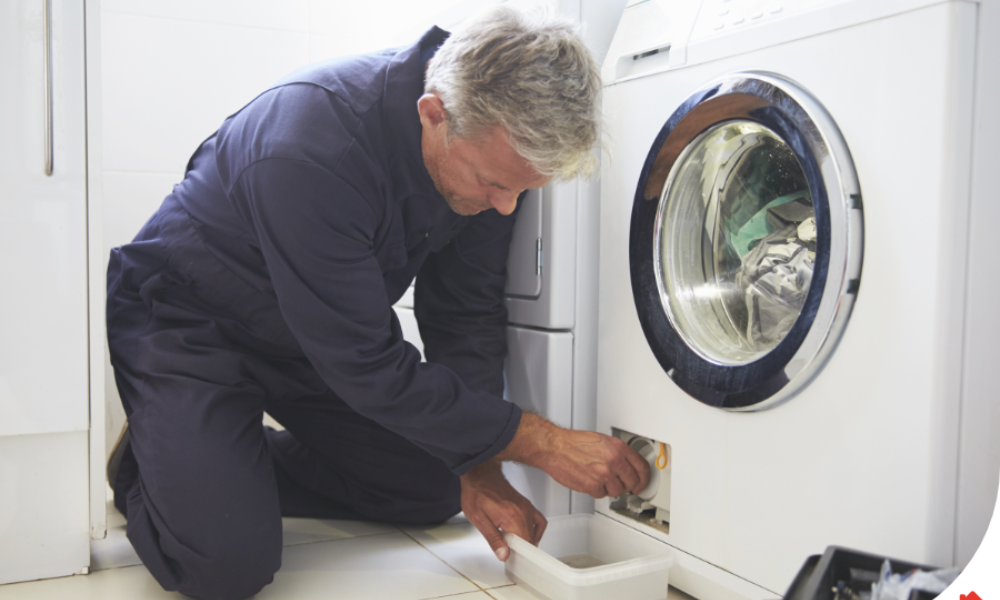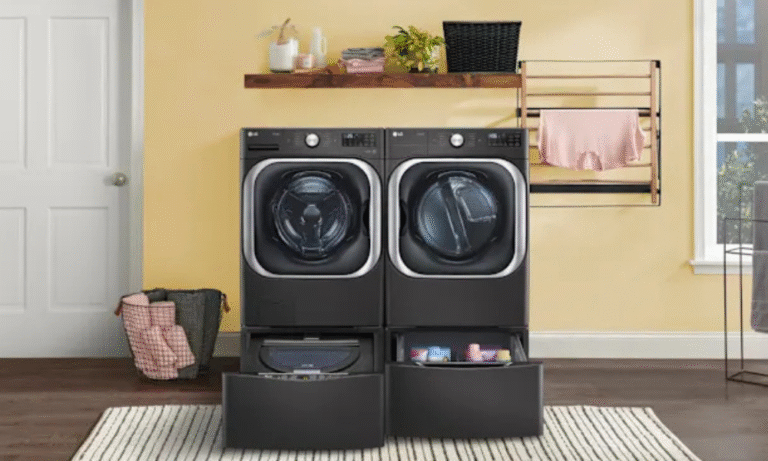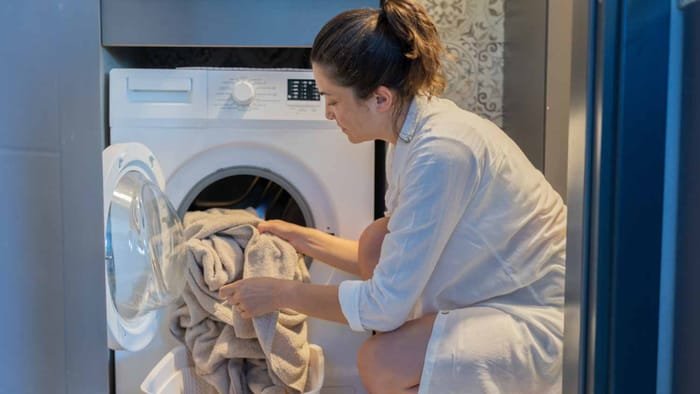Estimated reading time: 14 minutes
Last updated on August 23rd, 2025 at 01:28 am
A leaking washing machine can be annoying and may result in water damage to your house. This thorough guide attempts to save you time, money, and the discomfort of a broken appliance by helping you diagnose and resolve the problem. You may successfully solve the issue and experience leak-free laundry by locating the leak’s source, treating its internal and external causes, and taking preventative steps.
Identifying the Leak’s Source
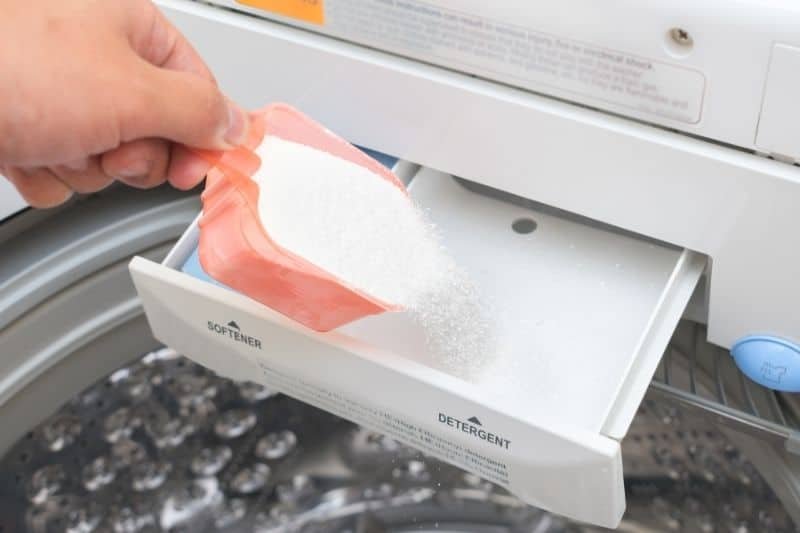
Photo Credit: inthewash
External vs. Internal Leaks
It’s critical to distinguish between internal machine leaks and external causes of leakage. Internal leaks can be brought on by broken pumps, valves, or tubs, whereas external leaks can be brought on by faulty hoses, loose connections, or damaged door seals. The source must be correctly identified in order to do focused troubleshooting.
Common Causes of Washing Machine Leaks
To effectively troubleshoot a washing machine leak, one must be aware of the common reasons. Water leaking might be caused by broken hoses, worn-out door seals, blocked drain pipes, or broken parts. In order to identify the source of the leak, it is required to evaluate each component and potential area of concern.
Troubleshooting and Fixing External Leaks
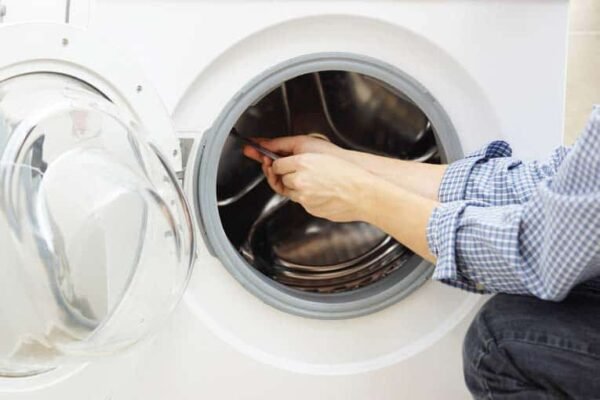
Photo Credit: hometips
If your washing machine develops an outside leak, it’s critical to fix it right away to avoid water damage and maintain the machine’s functionality. For external leakage, try these diagnostic techniques and fixes:
Identify the Source
Start by locating the source of the leak. Check the hoses, connectors, and valves in the vicinity of the washing machine. Find any outward indications of water dropping, collecting, or spraying.
Tighten Connections
Use a wrench or pliers to tighten any connections that are visible as being loose, such as hoses or valves. Avoid overtightening to avoid damaging the connections or threads. Make sure that every connection is firmly attached.
Replace Damaged Hoses
If the leak is coming from a hose, carefully inspect it for any signs of damage, such as cracks, bulges, or holes. It is advised to get a replacement hose if the old one is worn out or broken. Make sure the hose you choose is compatible with the model of your washing machine.
Check the Hose Washers
Over time, the washers within the hose connectors may degrade or wear out, which can cause leaks. Any worn-out or broken washers should be replaced with fresh ones. Make that the washers are correctly placed and that the seal is watertight.
Inspect the Drain Hose
If the leak is near the drain hose, check for any kinks, blockages, or damage. Remove any obstacles and straighten up any kinks. If the drain pipe is damaged, you might want to think about getting a new one.
Examine the Water Supply Valve
Inspect the water supply valve for any leaks or loose connections. It can be necessary to repair the valve if it is defective or damaged. If you’re unclear of how to replace the valve, speak with a qualified plumber.
Clean the Filter
A blocked or filthy filter might result in water leaking from the machine and backing up. To learn how to clean the filter, consult the user handbook. Cleaning the filter on a regular basis keeps the water flowing properly and avoids obstructions.
Check the Detergent Dispenser
If the leak is originating from the detergent dispenser, ensure that it is not overfilled or clogged with detergent residue. Avoid overloading the dispenser with fabric softener or detergent by carefully cleaning it.
Inspect the Door Seal/Gasket
If you have a front-loading washing machine, check the door seal/gasket for any signs of damage or wear. Leaks may be brought on by seal cracks, rips, or openings. To remedy the problem, if required, replace the door seal or gasket.
Consult a Professional Appliance Repair Technician
If you’ve attempted the aforementioned fixes but the leak still exists or if you’re unsure about making any repairs, it’s suggested to do so. They are able to precisely identify the issue and offer the required fixes or upgrades.
Always practice caution when working with water and electrical equipment. Before starting any troubleshooting or repairs, make sure the machine is unplugged and the power source is off. To minimize any potential dangers and guarantee a correct cure, it is important to get expert assistance if the leak is significant or you are unable to address the problem yourself.
Troubleshooting and Fixing Internal Leaks
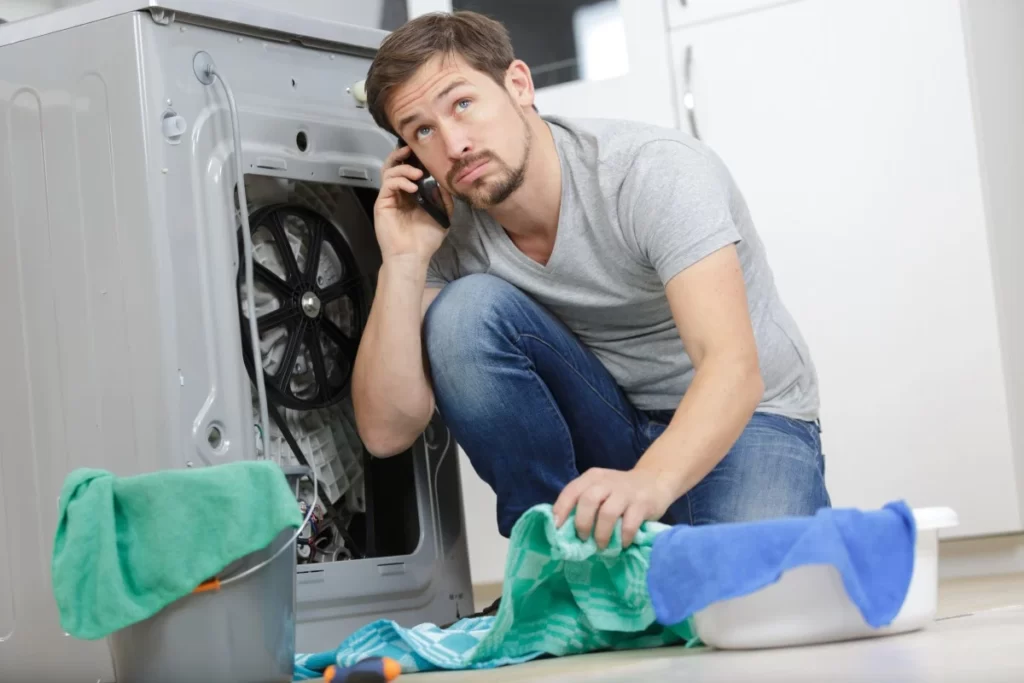
Photo Credit: expresssewer
Diagnosing Internal Component Issues
A washing machine’s functionality may be impacted and water damage may result from internal leaks. Here are some steps for troubleshooting internal leaks and fixes:
Determine the Location of the Internal Leak: Locate the internal leak in the washing machine. The tub, hoses, pump, or valves are typical locations. Inspect the machine for any indications of water accumulating, leaking, or spraying.
Check the Tub: Look for any cracks, holes, or damage in the washing machine tub. If you do, it could be required to either replace the tub or hire a specialist to fix it.
Check the Hoses: Check the machine’s internal hoses for leaks or loose connections. Replace any broken hoses if necessary and tighten any loose connections. Make sure the hoses are in excellent shape and are fastened firmly.
Examine the Pump: The Pump is in charge of removing water from the device. Verify the pump for any leaks or obstructions. The pump may need to be changed if you find a leak. For help, refer to the manufacturer’s instructions or a qualified technician.
Check the Valves: Look for leaks or loose connections in the input and output valves. If necessary, replace malfunctioning valves and tighten any loose connections. Verify that the valves are in good working order and are well sealed.
Examine the Detergent Dispenser: If the internal leak is originating from the detergent dispenser, it may be clogged or damaged. Make sure the dispenser is empty and that it is fully cleaned. If the dispenser is broken or not working properly, replace it.
Examine the Door Seal/Gasket: If your washing machine is a front-loader, look for any cracks or rips in the door seal/gasket that can indicate damage. One of the main Neoprene Gasket Uses is to prevent leaks by forming a tight seal. Internal leaks may be caused by a broken seal. If necessary, swap out the door gasket or seal.
Clean the Filter: Internal leaks might be caused by a dirty or clogged filter. To learn how to clean the filter, consult the user handbook. Cleaning the filter on a regular basis keeps the water flowing properly and avoids obstructions.
Seek Professional Assistance: It is advised to call a qualified appliance repair specialist if you have attempted the aforementioned fixes but the internal leak still exists or if you are unsure about making any repairs. They are able to precisely identify the problem and offer the required fixes or replacements.
Before starting any troubleshooting or repairs, make sure the washing machine is unplugged and removed from the power source. Because internal leaks might be intricate, it’s vital to use caution. To avoid more damage and guarantee a good cure, it is preferable to rely on expert aid if the leak is significant or you’re concerned about performing the repairs.
Repairing or Replacing Internal Components
The interior parts of a washing machine should only be repaired or replaced under careful supervision and, in most situations, by a trained appliance repair professional. Here are some suggestions to bear in mind:
Assess the Severity of the Issue: Determine whether the internal component issue can be repaired or if it requires a complete replacement. While some minor problems may be fixed by repairs, more serious problems can call for component replacement.
Consult the Manufacturer: For assistance, consult the washing machine’s instruction manual or get in touch with the manufacturer’s customer care. They may offer detailed information about the parts, their availability, and suggested fixes or replacement methods.
Evaluate Warranty Coverage: If your washing machine is under warranty, check the terms and conditions to see if the repair or replacement of internal components is covered. To start the repair procedure in such circumstances, it is advised to get in touch with the manufacturer or a licensed service facility.
Hire a Professional Technician: Internal component repairs can be challenging and call for specific skills and equipment. Hiring a qualified appliance repair specialist with experience fixing washing machines is often advised. They are able to precisely identify the problem, offer a trustworthy evaluation, and carry out the required maintenance or upgrades.
Consider Cost-effectiveness: Assess the cost-effectiveness of repairing or replacing internal components. In some circumstances, particularly if the washing machine is outdated or the cost of repairs is excessive, purchasing a new machine could be a better financial decision.
Genuine Replacement Parts: If replacement parts are required, make sure to use only those that have been approved by the manufacturer. Genuine components provide the best compatibility and performance since they are made exclusively for your washing machine model. Using fake or incompatible components could cause further problems and void any remaining warranties.
Safety precautions: When repairing or replacing internal components, put safety first. Before starting any repairs, always unplug the washing machine and disconnect it from the power source. To minimize any dangers or hazards, it is essential to rely on a qualified specialist if you are doubtful or uneasy about the repair procedure.
Regular Maintenance: Perform routine maintenance to increase the longevity of internal components. This includes maintaining the washing machine, using it appropriately, and swiftly resolving any problems. Regular maintenance lessens the need for expensive repairs or replacements and helps prevent internal component failures.
Keep in mind that using electrical equipment has some dangers, and poor repairs might make the machine even worse or dangerous. When in doubt, it’s advised to get expert advice from a licensed technician who can correctly identify the problem and offer the necessary repairs or replacements.
Preventing Future Leaks and Maintenance Tips
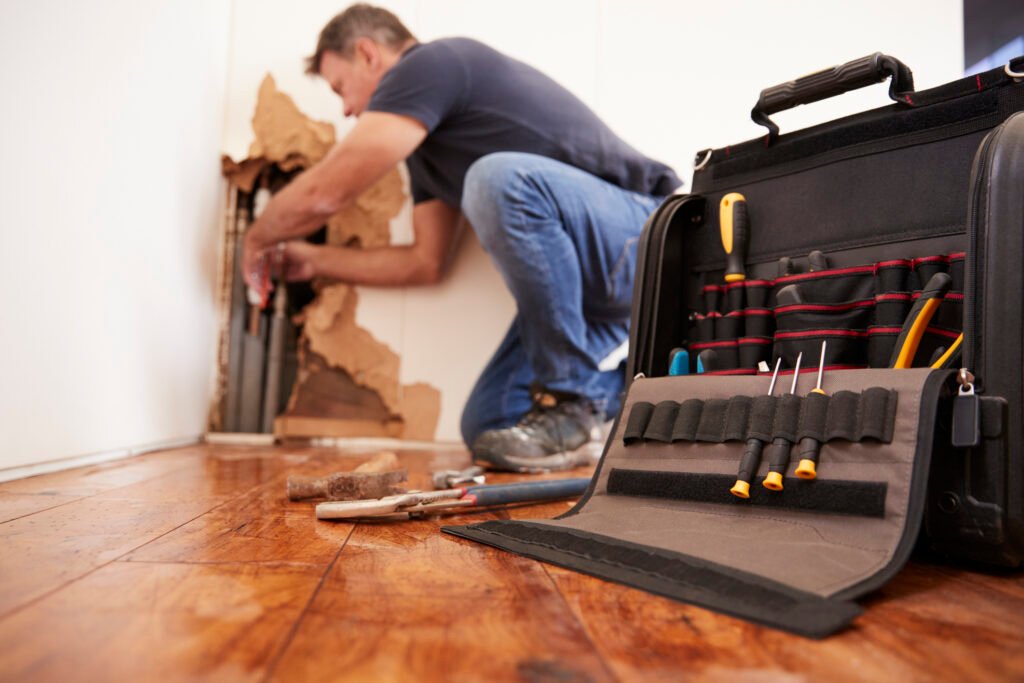
Photo Credit: safetyfirst
Maintaining your washing machine’s correct operation and preventing further leaks are essential. Here are some maintenance recommendations to help keep your equipment in good working order and minimize leaks:
Regularly Inspect Hoses and Connections: Check the hoses, including the inlet and drain hoses, for any signs of wear, cracks, or leaks. Make sure all connections are tight and secure. Any hoses that are damaged or degraded should be replaced right away.
Use High-Quality Hoses: Invest in high-quality, reinforced hoses that are specifically designed for washing machines. These hoses last longer and are less likely to leak or rupture. Take into account stainless steel braided hoses, which provide improved durability and strength.
Replace Hoses Every Few Years: Even with regular inspections, hoses can deteriorate over time due to usage and exposure to water. To reduce the possibility of leaks, it is advised to change the hoses every 3 to 5 years, or as instructed by the manufacturer.
Avoid Overloading the Machine: Overloading the washing machine can put excessive strain on the components and cause leaks. Observe the load capacity recommendations provided by the manufacturer and don’t go beyond the suggested weight for each cycle.
Use the Correct Amount of Detergent: Using excessive detergent can create excess suds and lead to leaks. To ensure the proper amount of detergent is used for each load, follow the washing machine’s instructions and those provided by the detergent manufacturer.
Regular Washing Machine Cleaning: Conduct regular cleaning of the washing machine’s dispensers, filters, and drums. The remainder, lint, and other debris that may block the system and result in leaks are removed thanks to this. To find out how to clean something specifically, consult the user handbook.
Clear the Drain Pump Filter: To avoid clogs and guarantee effective water drainage, the drain pump filter should be cleaned periodically. For directions on where to look for and how to clean the filter, consult the user handbook. The filter should be maintained on a regular basis to avoid leaks and drainage problems.
Level the Machine: Ensure that the washing machine is level on the floor. If required, level the machine’s feet with a leveling tool. A machine that is correctly leveled aids in the appropriate distribution of the load and reduces excessive vibrations that might cause leaks.
Avoid Slamming the Door: By treating the washing machine door gently, you may keep the door seal/gasket’s integrity. Avoid slamming or closing the door firmly because doing so might lead to leaks and damage.
Address Issues Promptly: If you notice any unusual noises, vibrations, or leaks, address them promptly. Delaying fixes might make the issue worse and cause more harm. If you’re unsure of the reason or the remedy, speak with a qualified technician.
You can drastically lower the likelihood of leaks in your washing machine by using this maintenance advice. Your machine will last longer, function more efficiently, and remain in good working order with regular maintenance, correct use, and prompt repairs or replacements.
Frequently Asked Questions
1. Why is my washing machine leaking water?
– There may be a number of causes for a washing machine leak. A defective water entry valve, a clogged drain line, or an inoperable pump are a few examples of typical reasons. To choose the best treatment, it’s critical to pinpoint the exact source of the leak.
2. How can I determine the source of the leak in my washing machine?
– Start by examining the door seal for any evidence of damage or wear in order to locate the leak’s source. Check for leaks or loose fittings in the connections and water inlet valve. Check for cracks or obstructions in the drain pipe. Finally, check the pump for any obvious leaks or broken components. You can identify the source of the leak by routinely examining these parts.
3. Can I fix a leaking washing machine on my own?
You might be able to repair a leaky washing machine on your own, depending on the kind and severity of the leak. You can try to fix a small problem, such a loose connection or a clogged drain line, by tightening the fittings or clearing the obstruction. However, it’s advised to get expert assistance from a certified specialist if the problem is more complicated or if you’re unclear of how to proceed with the repair.
4. How do I prevent my washing machine from leaking in the future?
– There are a few maintenance suggestions you may use to stop leaks from happening again. To make sure the door seal is in tact and clear of dirt, examine and clean it frequently. Inspect the hoses and water inlet valve for wear or leaks, and repair them as necessary. Avoid overloading the washer since it might put too much stress on the parts. Be careful while using detergents as well because excess suds might result in leaks. By taking these precautions, you may lessen the likelihood that your washing machine will leak.
5. Should I replace my washing machine if it continues to leak despite repairs?
– If your washing machine leaks even after you’ve tried to fix it, there may be a bigger problem at the root of the problem. In such circumstances, it is advisable to seek the advice of a qualified technician to evaluate the machine’s condition. They may offer professional guidance on whether it would be more cost-effective to replace the device or repair it. Sometimes, older machines or those with major faults may require replacement to ensure efficient and reliable laundry operations.
Conclusion
By following this comprehensive guide, you’ll be equipped to troubleshoot and fix a leaking washing machine effectively. You may have a leak-free and effective laundry experience by promptly identifying the leak source, treating both internal and external causes, and putting preventative maintenance measures into place. Remember, it is always best to seek expert assistance if you run into complicated problems or lack confidence in completing repairs.
